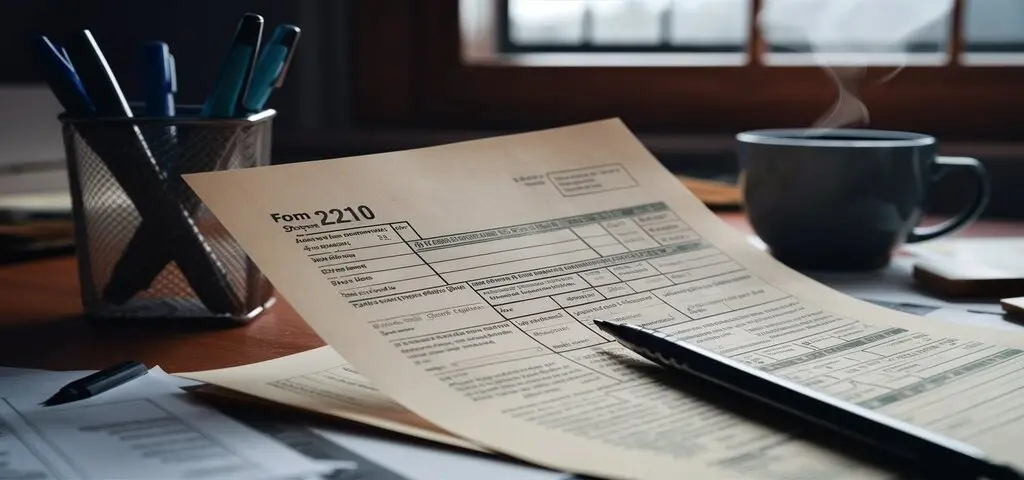
Internal Revenue Service form 2210, sometimes referred to as Underpayment of anticipated Tax, is used to ascertain penalty charges for underpayment of anticipated taxes.
Should one fail to pay enough projected taxes or pay underpaid for the year, IRS Form 2210 can be utilized to determine the penalty owing. Quarterly payments help to estimate taxes; Form 2210 is used to determine whether sufficient payments have been made over the quarter to prevent underpayment of taxes.
This raises the next issue of who has to complete form 2210.
Usually, Form 2210 is filed if:
This was not done consistently, resulting in the necessary projected tax payments lacking.
You did not get enough taxes deducted from your pension, earnings, etc.
Regarding: If your total gross income was more than $150,000, your expected tax payments and any withheld taxes were at least 90% of the sum of your current tax or 100% of your previous year's tax.
Suppose you had to pay a penalty for underestimating your tax burden in the year; then, in addition to your yearly return, you would have to file Form 2210. As it is right now, it lets the IRS work out as well as decide the penalty amount.
Individuals, estates, and trusts use Form 2210—an application for approval to make advance payments of expected tax to the Internal Revenue Service—to ascertain the projected tax payments to pay during the year.
Should you discover that you owe a penalty for underestimating taxes, document number 2210 must be attached to the yearly Form 1040 tax return. The due date is either October 15th if that was applied for or April 15th for submitting your tax returns.
How are Form 2210 penalties calculated?
There are two possible calculations for the underpayment penalty:
One of two calculations determines the underpayment penalty:
Another kind of penalty sometimes imposed on the taxpayers is the one based on underpayment of expected taxes.
Whether through expected tax payments or paycheck withholdings, this penalty is applied should you neglect to pay enough projected taxes over the year. For every underpayment each quarter the IRS imposes interest plus a penalty.
The penalty is calculated at three percent added to the federal short-term interest rate.
Another kind of penalty is based on underpaying taxes from the previous year, computed at 0.25 percent of the tax underpayment per month.
Should the total income for the stated year be more than fifteen thousand five hundred dollars ($15000), this penalty applies where you failed to pay at least 90 percent of the total tax due for the current year or one hundred percent of the amount shown on the return for the previous year. The annualized income installment method is a form used in the computation of the penalty.
The penalty amount so depends on interest rates where the underpayment was made during the year.
Steering clear of and lowering penalties
Any one of the following could help you to either avoid or reduce the penalty:
You should use the yearly payment approach when paying your dues if your income changes and you have either minimal or no taxes to pay.
She said: They should be qualified for a waiver should the underpayment result from a calamity, disaster, or another unexpected event.
The following instructions apply on filling the Form 2210:
You must decide which part applies while completing Form 2210:You will have to decide which section of Form 2210 fits you:
Part I Regarding the normal penalty for underpaid estimated taxes, the following relates:
Should the surviving spouse choose to accept the annuity and make the election in line with Internal Revenue Code rules, the payment will be made annually and the following guidelines will apply:
Part III: Should some events lead to a waiver given to you,
This form lets you figure out the penalty you owe by aggregating the expected payments you should make and matching them with the actual payments. Your Form 1040 tax return then shows the total penalty amount added on.
Form 2210 helps ascertain, document, and pay any penalty for underestimations of taxes due either through projected tax payments for the year or from withheld amounts. Filing the form helps the IRS identify and charge an individual appropriate penalty amounts compliant with statutory criteria and exemptions. See a tax professional to also make sure you are paying just the necessary penalties and that all Form 2210 parts have been correctly filled.
Contact us here for accounting services now!

Get Help Fast!
My Accounts Consultant Helps Accounting & Bookkeeping Services help you save money, better understand your business and find the Accounts problems before they hurt you.